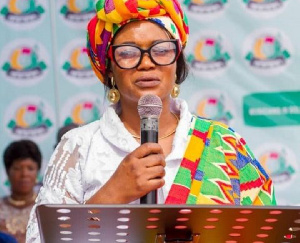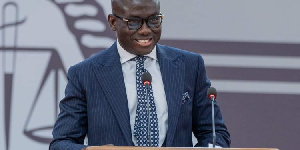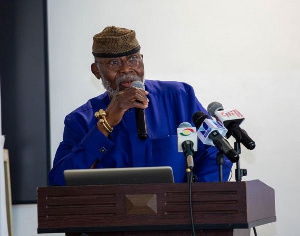Opinions of Saturday, 13 July 2013
Columnist: Quaah, Amos Ofori
Why, O why Must Ghana go Nuclear?
Part 1
By Dr A. Ofori Quaah, Fltwick, UK
“There were two ways to be happy: improve your reality, or lower your expectations”
(By Jodi Picolt in Nineteen Minutes)
I tend to develop a kind of skin itch each time I read about this mad idea of Ghana going nuclear. To start with, President Nkrumah’s vision for the Ghana Atomic Energy Commission was for applied atomic research, in engineering, the physical and biological sciences, agriculture and medicine. Even after his overthrow, the original programme continued in earnest and if successive governments had maintained the momentum, Ghana would have been at the forefront of the Genetically Modified (GM) and Magnetic Resonance Imaging (MRI) revolution.
During the long vacation of 1973, I did Vacation Training under the UST industrial attachment programme at the Commission. The place was buzzing with activity under now Very Rev Dr B. W. Garbrah, as Officer-in Charge.
There were exciting research programmes in engineering, physics, chemistry, biology, biochemistry, agriculture, etymology, among others. One Friday afternoon, our colleagues in agriculture harvested a pawpaw fruit that had been grown using what will today be called genetically modified techniques. Twelve of us hungry lads from UST and Legon could not finish it. There were similarly huge harvests of tomatoes, fresh corn, garden eggs, etc. That was research towards national food self-sufficiency!
There were live tests of what would have been one of the first total body scanners in Africa, that had been designed and built with local materials, by scientists and a senior technician of the Commission.
A research programme in which wood was irradiated to enable it withstand the vagaries of the weather, for construction purposes, was well advanced in those days. Its products shone like glass and would have provided the materials for low cost housing in Ghana.
There were equally impressive research programmes in etymology, to eliminate the “akate” pest that had been a thorn in the side of cocoa farmers for decades, as well as the coconut beetle and mosquitoes. The idea was to sterilise the males of these pests and release them into the wild as a means of reducing their respective populations and eventually killing them off.
One of the projects I did involved a research study of the rate at which people in the tropics lost body water during the day and its possible effect on health, using tritium as tracer.
Even Acheampong with all his faults, continued to support the research activities of the Commission in his time.
As far as energy for local consumption and industrialisation was concerned, President Nkrumah’s vision was to build a hydroelectric dam on every river in Ghana, beginning with the Volta through Bui, to Pra and others. Districts that had good sized rivers were to get their own dams for power generation and water supply. I have not looked at the “Ten Year Development Plan” for a while but I believe that is what the plan for national energy self-sufficiency and even for export was all about. The quest for nuclear know-how was more towards, “The African Bomb” than anything else. The argument at the time as I remember, was “The Europeans had their European Bombs, The American had theirs, Germany and America were suspected to be secretly assisting Israel to develop atomic capability, while the British were secretly conniving with or simply looked the other way as Apartheid South Africa pursued her Chemical and possibly atomic weapons programmes.”
So where did this fancy idea of nuclear power come from? Clearly, even if President Nkrumah’s vision included nuclear energy, his strong education foundation (which was later refined by Professor Busia’s original JSS/SHS concept, rural development and indigenisation of Ghanaian universities), has been damaged beyond recognition by a few selfish, shallow-minded and incompetent individuals. If we cannot design, maintain and enforce simple domestic and market wiring, we have no business dabbling in complex and potentially risky nuclear power generation with all its safety and waste storage and management headaches!
Location
Where exactly is this nuclear power station going to be sited? Because of the sensitivity of their operations, international Health and Safety regulations require that sites for nuclear power are selected in such a way that risks to their employees and the general public are as low as practicable. Critical site evaluation factors include availability of large quantities of cooling water, low population density that is evenly distributed around the site, geophysical, geological, hydrological, meteorological, seismotectonic and security risks.
If as it is being proposed it is to be built by the Russians, then it is most likely to be the Light Water Graphite Reactor (RBMK & EGP) type because that is the commonest in Russia, fifteen of them in use at present. The Russians also have the Fast Neutron or FBR, but only one of them has been in operation in Russia so far. The RBMK uses water as coolant and therefore of necessity, must be built near the sea because the major rivers in Ghana have been affected by poor environmental practices as well as the problems posed by worldwide climate change. According to industry experts, the RBMK is not very efficient because apparently with its fixed graphite moderation, excess boiling simply reduces the cooling and neutron absorption without inhibiting the fission reaction, and so a positive feedback problem can arise. As a result, this type of reactor has never been built outside Russia (World Nuclear Association, June 2013)
Are we about to experience the saga of the ice breakers that were sold to Guinea in the early 1960s as farm tractors that never worked? Those who worked at the GAEC in the early 1970s may remember the elephant-size scintillation counter in the Physics Department that never worked.
But even more importantly, I have in front of me as I write, a detailed map of the Coastal Boundary Fault, that I mapped a little while ago, together with some structural features off the coast of Ghana (to be published soon.) The fault runs along the whole coastline of Ghana. Seismologically, this has been one of the most active faults in Africa over the past 500 years, having caused devastating earthquakes that have respectively destroyed the whole of the Axim District, Takoradi, Komenda, Nyanyanu, Accra itself and Prampram, among others.
Following the Fukushima, Japan earthquake, the International Atomic Agency undertook a major study of the world’s nuclear facilities in relation to their proximity of major earthquake epicentres and concluded that the mean distance from a nuclear plant to the nearest earthquake of Magnitude 7 and above, is 785 miles (1868 km). The Coastal Boundary Fault is only 25 kilometres offshore. In other words, by this worldwide criterion, no point on the coast of Ghana qualifies to be the site of a nuclear facility. In the course of planning, designing and supervising several onshore, near shore and marine seismic acquisition programmes in addition to doing geophysical/geological field work in Ghana, I have travelled through every fishing/coastal community along the coast of Ghana and I am convinced that short of removing and disrupting the lives of hundreds of thousands of people, the coastal region of Ghana does not qualify in terms of population density and local socio-economic reasons, for siting a nuclear facility.
Public Hearings
This issue is potentially so profound that it cannot be left to the Ministry of Energy and the Ghana Atomic Energy Commission alone to discuss behind closed doors over coffee and biscuits, and foisted on the long suffering people of Ghana. Even before discussions can begin with the donor, if that is the right word, an independent group made up of the Geological Survey Department, NADMO and Lands Department should be constituted to hold open meetings with every town, village and hamlet along the coast of Ghana, to tell the people exactly what is being planned, its benefits, its effect on their lives, the potential risks involved and what it will mean for generations unborn. And I will also suggest that the communities be provided with independent expert advice at the expense of whoever is mooting this idea. Also, every community should be able to say “Not in my Backyard”, and their decision must be respected.
The next set of meetings should be organised in every district and regional capital of the Western, Central, Greater Accra, Eastern and Volta Regions, to inform the people and canvas their views on the project. Each of these groups should be provided with independent advisers to explain issues in detail. Finally, there should be an honest national consultation exercise, followed by an open debate to ensure that the people understand exactly what is to be done in their name.
Cost Implications
According to Wikipedia, China built four Ap1000 nuclear power stations in 2009 for $8bn. That unit cost of around $2bn seems to be average for North America, Europe and Asia. That however, does not include over-runs. Also this average cost does not factor in the mean distance from earth quake epicentres that I mentioned earlier. If we factor in earthquakes, the effects of coastal erosion, resettlement of local communities and the ’African effect’ whereby everything sold to African countries comes with extra costs in translators, ‘official and unofficial contingencies’, we will be looking at $3.5 to 4bn.
Greenpeace has stated that the cost of providing short-, medium- and long-term waste storage and management for one nuclear power station in the UK is about £1.5bn. This again will come at a premium for Ghana, a country that can’t manage the domestic waste of its national capital. Even if Russia or anybody else decided to donate a nuclear power station to Ghana for free, its running and maintenance would require that money is taken from hospitals, schools, roads and other social services, to run it and that clearly is unacceptable for a country with a life expectancy of 62 or thereabouts.
Following the Fukushima earthquake, Tsunami and their aftermath, advanced Britain has revised down its nuclear programme considerably. The largest earthquake that has occurred on the whole of the British Isles over the past one hundred years was Magnitude 6.1. Germany, Switzerland and the Scandinavian countries are actually winding down their nuclear power programmes.
According to Professor Adei, as he was reported on Ghanaweb last week, the private and public schools of Ghana are together providing useable education for just 20% of the young people of Ghana, and I have no reason to doubt him because I have written about it before from personal experience. In other words, at the pre-senior high school level alone, a whopping 80% of our population is functionally illiterate. Not surprisingly the politicians have a large pool of young people they call foot soldiers, “foolsoldiers,” will be more appropriate! It will be highly irresponsible, perhaps even criminal, for a country with such pitiful human development statistics to spend even $1bn on something for which there are safer, cheaper, and more practical and more sensible options.
If as we used to say in our university days, “we have $1bn that is lying and breathing comfortably and peacefully somewhere without any threat on it,” let us use it to eliminate all primary schools under trees, by providing classrooms, sports, arts and craft and music facilities and challenge ourselves to attain 100% literacy in our country in a decade. Cuba did it between 1959 and 1969, from a base of about 15%, with much fewer natural resources than Ghana.
In part two, I shall look at security and other implications and suggest alternatives. This is meant for sensible debate. No insults, please.
Stay blessed
Entertainment









